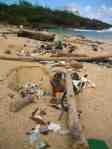“Humanity is at a critical point in time, with our planet currently existing in a fragile ecological state, with global warming hastening unheard of changes, all amplifying the fact that we need all the help we can get.”
– John Dahlsen
Creating his artwork out of found objects from the sands of the Australian coastline, contemporary Artist John Dahlsen beautifully highlights many universal environmental themes using a variety of mediums. He largely uses plastics in his artwork to draw attention to the poor global ecological state of pollution. These plastics and other found objects are each affected by sun, sand and the ocean, their form faded and rounded by the elements.
 When discussing his 2003 series of plastic bag artworks, Dahlsen pointed out that the Irish Government has imposed a 10 cent levy on the use of these bags some years ago, which saw the consumption of this product decrease by approximately 90% within a year- a reduction of billions of plastic bags per year! The message is in the medium; plastics still contribute to a significant amount of pollution on an international scale. We can all find use in other more environmentally friendly materials and with a combined effort we can eliminate using plastics bags and the litter that they create on land and in the sea. Gold Coast (above) was created entirely from ‘ocean litter’, and Dahlsen realised during his beach searches that ocean litter is a worldwide phenomenon affecting beaches on a global scale. Dahlsen insists on working with these found materials until they tell their story- which includes those “underlying environmental messages inherent in the use of this kind of medium”. Thousands of tonnes of plastics used by humans are being dumped along shorelines around the world every day, killing local animal species and polluting the ocean. “Despite my outrage at this environmental vandalism”, stated Dahlsen, ” I returned to the beach daily to find more pieces for my artist’s palette.”
When discussing his 2003 series of plastic bag artworks, Dahlsen pointed out that the Irish Government has imposed a 10 cent levy on the use of these bags some years ago, which saw the consumption of this product decrease by approximately 90% within a year- a reduction of billions of plastic bags per year! The message is in the medium; plastics still contribute to a significant amount of pollution on an international scale. We can all find use in other more environmentally friendly materials and with a combined effort we can eliminate using plastics bags and the litter that they create on land and in the sea. Gold Coast (above) was created entirely from ‘ocean litter’, and Dahlsen realised during his beach searches that ocean litter is a worldwide phenomenon affecting beaches on a global scale. Dahlsen insists on working with these found materials until they tell their story- which includes those “underlying environmental messages inherent in the use of this kind of medium”. Thousands of tonnes of plastics used by humans are being dumped along shorelines around the world every day, killing local animal species and polluting the ocean. “Despite my outrage at this environmental vandalism”, stated Dahlsen, ” I returned to the beach daily to find more pieces for my artist’s palette.”
Our awareness and consciousness about the environment and art can be shifted by viewing Dahlsen’s artwork. Even if it just fractionally, he states that this shift “makes all of his art worthwhile”. The theme of recycling is consistent in almost all of Dahlsen’s work, and the fact that he creates these aesthetically beautiful artworks purely from litter and recycled materials supports his powerful message.
Visit www.johndahlsen.com/ to see more of Dahlsen’s artworks.
Amy Jackson


Some very powerful words from the artist there!
I love the way Dahlsen is able to make such beautiful works out of objects that had previously been regarded as rubbish. His plastic bag works remind me of a piece by Lauren Berkowitz, another Australian artist who uses discarded materials to created stunning sculptural and installation pieces. Check out “Bags” (1994), http://www.laurenberkowitz.com.au/work_9.html. Constructed from 3000 shopping bags attached to two panels of netting hung from the ceiling, Berkowitz’s vertical towers of plastic invite viewers to walk through the pathway they create and physically comprehend how some household items affect the environment. Berkowitz, like Dahlsen, forces us to contemplate what happens to our rubbish after it is collected. Berkowitz and Dahlsen both create beautiful artworks out of otherwise ignored household items, whilst reminding us of the wasteful practices of modern society. As you’ve said, using rubbish in this way makes Dahlsen’s work very powerful. The fact that he is able to find such a diverse range of materials for his work certainly makes me more passionate about recycling!
I really like the way Dahlsen’s works are reminiscent of beach landscapes or paintings of the ocean. He makes the connection between non-biodegradable waste and the ocean, where most of our waste ends up. His work also reminds me of the “Great Pacific Garbage Patch”, an area in the Northern Pacific Ocean where ocean currents collect rubbish and create a “trash vortex”. For more info: http://www.greenpeace.org/international/en/campaigns/oceans/pollution/trash-vortex/.
Thanks for the great post Amy!
Michelle.
Both works of Dohlsen and Berkowitz are fantastic! I concur with you Michelle, such artworks really intensify the focus on the importance of recycling, along with the implications of thoughtless disposal of rubbish on our local environment.
Their art practices reminded me of two Indigenous artists that I have come across, Yvonne Koolmatrie and Treahna Hamm. Through the use of discarded materials as well as indigenous plant life, the local women create sculptural pieces to comment on the health of the Murray River. I will feature their work in a separate post – Kylie